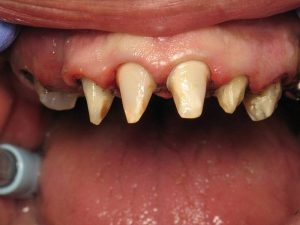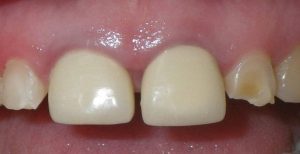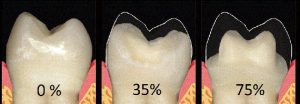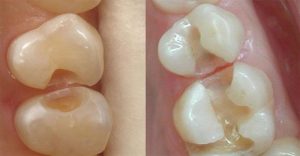Just like in medicine, dentistry continues to learn that the less invasive the treatments (medications, procedures or surgery) are, the less secondary injury to the treated tissues, the less recuperation time, the less the post-surgery or post-procedure pain, and the faster and more complete the healing will be.
 Figure 1
Figure 1
For over a hundred years, dentist have used crowns to repair badly damaged teeth. Sadly, crowns are one of the most invasive procedures in dentistry, requiring extensive tooth removal (Fig. 1), and even more damaging, traditional techniques lead to soft tissue damage (gums), and subgingival restorative margins (leaving of foreign materials (margins) below the gum), which will act like irritant, similar to tartar and leading to gum disease (Fig. 2). The collateral injury caused by the crown procedure to the tooth, nerve of the tooth (pulp), and the gums (gingiva) is quite extensive, with many side effects. Many forms of filling and other dental restorative procures can be done with similar invasive techniques and negative consequences (see Literature References).
 Figure 2
Figure 2
Dentistry, like medicine, has more minimally invasive options, and in dentistry, the cutting edge “Supra-gingival Minimally Invasive Techniques” have been designed to provide a healthier alternative to the above traditional dentistry and will provide the patient with less injury during the procedure, less collateral damage, faster and more complete recovery, less pain, and long-term healthier and more successful results.
What is Supra-gingival, Minimally Invasive Dentistry?
 Figure 3
Figure 3
Supra-gingival, minimally invasive dentistry is a modality or style of dentistry which uses the latest materials and innovative techniques to very intentionally keep restorations (fillings, crowns, veneers, onlays, etc.) above the gum line, and which uses the most minimally-invasive techniques available. This also applies to fillings; oftentimes, too much tooth is drilled away, and some dentists unnecessarily go below the gum line unnecessarily! (Fig. 5: Observe how much more tooth is cut away with traditional techniques.)
Why Aren’t Supra-gingival, Minimally Invasive Techniques Used by All Dentists?
 Figure 4
Figure 4
Like many cutting-edge techniques, supra-gingival minimally invasive techniques are newer and require additional training. These techniques sometime require the use of more expensive materials and equipment. Supra-gingival minimally invasive techniques are extremely well-researched and extremely successful. They have been used, researched, and published by a few of the leaders in minimally invasive dentistry (please see Literature References for more information).
Benefits of Supra-gingival, Minimally-Invasive Dentistry:
 Figure 5
Figure 5By minimizing the amount of tooth drilled away and staying away from the gum:
- The patient maintains as much natural, healthy tooth structure as possible, which leads to better durability of the tooth itself.
- During the procedure, the dentist minimizes injury to tooth, pulp (nerve), and gums, leading to faster recovery and less pain.
- The restoration is kept above the gum as much as possible, which decreases chances of gum disease caused by subgingival margins and maintains healthier gums.
- The nerve of the tooth is much less traumatized, which often prevents the need for unnecessary root canals treatments.
Overall, supra-gingival, minimally invasive dentistry is the healthier form of restorative dentistry.
For more information from the leaders in adhesive, minimally invasive, hands-on dentistry, sign up to receive our entire video library for free.
In our video library, you can also expect videos on:
- Direct composite & adhesion
- Minimally invasive implant dentistry
- Occlusion & worn dentition
- Supra-gingival restorative dentistry
- Team & office education
- And more!







